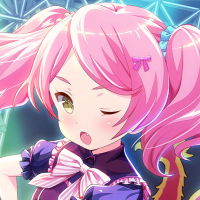Rhythm:Introduction
| Rhythm Game Walkthrough | |
|---|---|
| Introduction | |
 | |
| Next Page | |
| Installation | |
| Previous Page | |
| Walkthrough | |
| Walkthrough Navigation | |
| Walkthrough Project | |
Previous Page: Walkthrough
Welcome to the second page of the rhythm game walkthrough! This is the introduction page, where Girlfriend Note will be explained in great detail. This is where you will, hopefully, learn a lot about the game, who it's meant for, and whether or not you'd be interested in playing the game.
For those of you who aren't familiar with the Girlfriend Kari series or the original card game, I recommend you checking out the Girlfriend Kari page to briefly learn about the original game and series. After all, the rhythm game uses the same characters!
But anyways, you might be asking - what is Girlfriend Note and why should I play it? Isn't it all in Japanese!? Is it really worth my time?
Well, if you're looking for a cute anime rhythm game, you're in the right place.
Introduction
Girlfriend (♪) (also known as Girlfriend Onpu and Girlfriend Note) is a 3D rhythm game that was supposed to have been released on December 1st, 2015, but due to server failure and a lot of unexpected problems, the game was left unplayable until roughly December 18th, 2015. It's a mobile rhythm game similar to Love Live: School Idol Festival and the Idolm@ster rhythm games, and is playable on Android and iOS. The game itself is considered a spin-off of the original Girlfriend Kari series, as it uses the same characters and voice actresses from the card game, although introducing new characters from rival schools to advance the plot of the rhythm game.
You might be wondering - what prompted the creation of a rhythm game to the already successful RNG simulator, Girlfriend Kari? Well there are a few reasons.
The original Girlfriend Kari became incredibly popular in Japan as a social card game - with over 6 million registered users to date! Ameba deployed a simple buisiness strategy - use the appeal of cute cards depicting anime girls released at a surprisingly fast rate to keep players constantly returning for more. And even more - make the drop rates abysmally low so hardcore users will be almost forced to dish out cold, hard cash to obtain the super rare cards that they want. It's a simple strategy, but it worked.
Girlfriend Kari has become popular to the point that the series boasts its own magazine, radio, and giant booths at large conventions. Of course, the game is only that popular in Japan due to the game being fully in Japanese and somewhat challenging for foreign players to get into.
Nonetheless, with its rising popularity, an Anime adaptation was created. Although somewhat lacking in quality, the anime was successful as an advertisement to the series. Along with the anime, a bunch of character song albums were released, each containing five to six songs that a specific character's voice actress sings.
Now, what's the best way to make money off of a bunch of character songs that have already been released? That's right. You create a rhythm game out of them. And thus, Girlfriend Note was born.
Gameplay
As stated above, the core gameplay is very similar to Love Live: School Idol Festival and The iDOLM@STER Cinderella Girls: Starlight Stage. Players will assemble units of girls categorized according to various attributes (here, just according to five colors: Pink, Orange, Yellow, Green, and Blue) and use these units to score well on songs.
Actually playing songs takes after SIF more than Starlight Stage; the tap zones are eight hearts arranged in a semicircular fashion, very close to SIF's 9-circle semicircular layout. The bottom center, however, gives an entirely different element, unseen in either SIF or Starlight Stage: a disco ball that the player must keep spinning for a score bonus.
Unit composition resembles the others a decent amount, but there's also another element in play that neither SIF nor Starlight Stage feature: clothing! You can equip a hat slot item (like glasses, a headband, a barrette, etc), a body slot item (like a dress), and a leg slot item (like boots, sandals, etc). All clothing is also color-attributed and gives a stat bonus, and when playing, you can select up to two of your three clothing items to be used for their abilities, which you can activate while playing the song by tapping on an icon on either side of the screen.